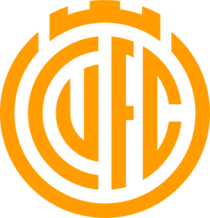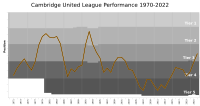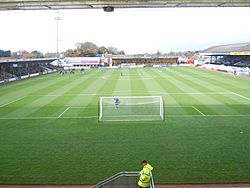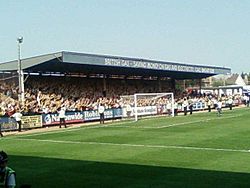Cambridge United F.C. facts for kids
 |
|||
| Full name | Cambridge United Football Club | ||
|---|---|---|---|
| Nickname(s) | The U's | ||
| Founded | 1912 (as Abbey United) | ||
| Ground | Abbey Stadium | ||
| Capacity | 7,937 (4,321 seated) | ||
| Owner | Paul Barry (75.01%), Mark Green (24.99%) |
||
| Chairman | Paul Barry | ||
| Head coach | Neil Harris | ||
| League | League Two | ||
| 2018–19 | League Two, 21st of 24 | ||
|
|
|||
Cambridge United Football Club is a professional football team from Cambridge, England. They are often called "The U's." The club plays its home games at the Abbey Stadium, where they have been since 1932.
Cambridge United was started in 1912 as Abbey United. They changed their name to Cambridge United in 1951. The team played in local amateur leagues for many years. They joined the Southern Football League in 1958.
Under manager Bill Leivers, they won the Southern League Premier Division twice. This helped them join the Football League in 1970. They moved up from the Fourth Division in 1973. After a quick relegation, they won the Fourth Division title in 1977. They then earned another promotion the next year. The team stayed in the Second Division for six seasons.
Later, manager John Beck led them to promotions in 1990 and 1991. They even reached the Second Division play-offs in 1992. After some tough years, they were promoted again in 1999. In 2005, they left the Football League and joined the Conference. They stayed there for nine seasons.
Cambridge United reached the play-off finals twice in the Conference. They finally won promotion back to the Football League in 2014. After seven seasons in EFL League Two, they were promoted to EFL League One in 2021. This happened under manager Mark Bonner. They were relegated back to League Two at the end of the 2024-25 season.
The team usually wears amber and black at home. They have tried different designs over the years. The club has strong ties to the community. The Cambridge United Community Trust does a lot of charity work. The Abbey Stadium is about 2 miles east of Cambridge city centre. It can hold 7,937 fans.
Contents
Club History
How the Club Started
The club began in 1912 as Abbey United. It was named after the Abbey area of Cambridge. Another club called Cambridge United existed from 1909, but it was not connected to this team.
For many years, the club played in local amateur leagues. They moved to different grounds around Cambridge. They finally settled at the Abbey Stadium. In 1949, the club became professional. They changed their name to Cambridge United in 1951.
They played in the Eastern Counties League. In 1958, they finished second and moved up to the Southern Football League. Three years later, Cambridge United reached the top division of the Southern League.
Joining the Football League: 1970-2005
In 1970, Cambridge United joined the English Football League. They replaced Bradford (Park Avenue). After three seasons, they were promoted from the Fourth Division. However, they went straight back down.
Ron Atkinson became manager. He led Cambridge United to two promotions in a row. This took them to the Second Division in 1978. Atkinson left for West Bromwich Albion in January 1978. John Docherty took over and finished the second promotion.
Cambridge United reached their highest league position in 1980, finishing eighth in the Second Division. But the 1983–84 season was very tough. They set a league record for most games without a win (31). This record was later broken. They were relegated again in 1984–85. These two relegations put Cambridge United back in the Fourth Division. This was the lowest professional league at the time.
The early 1990s were the club's most successful time. John Beck became the new manager. In May 1990, the club played at Wembley Stadium for the first time as a professional team. They won the Fourth Division play-off final. This earned them promotion to the Third Division. Dion Dublin scored the only goal against Chesterfield.
Under Beck, United also reached the FA Cup quarter-finals in 1990 and 1991. They won the Third Division title in 1991. In 1992, United reached the play-offs after finishing 5th in the Second Division. They hoped to join the new Premier League but did not succeed. This was their highest league finish ever.
The next season, John Beck was sacked. The club was relegated from the new First Division. Another relegation followed two seasons later. United returned to Division Two but were relegated in 2002. They had a good run in the Football League Trophy, reaching the final. They lost 4–1 to Blackpool at the Millennium Stadium in Cardiff.
In 2005, after 35 years, Cambridge United was relegated to the Football Conference. This caused money problems. The club went into administration on April 29. On July 22, 2005, the club came out of administration. They sold their Abbey Stadium home for £1.9 million earlier that season to stay afloat.
In the Conference: 2005-2014
Before the 2006–07 season, Lee Power became the new chairman. Jimmy Quinn was appointed manager. After a difficult start, he guided Cambridge away from another possible relegation. They won five of their last seven games.
In the 2007–08 season, Quinn led Cambridge to their longest unbeaten start (twelve games). The club also reported major sponsorship deals. Chairman Lee Power resigned halfway through the season. Wayne Purser replaced him. United finished 2nd and qualified for the play-offs. They beat Burton Albion but lost 1–0 to Exeter City in the final at Wembley Stadium.
After the play-off loss, many players left. Manager Jimmy Quinn also departed. Gary Brabin took over. United finished 2nd again in 2008–09. They reached the play-off final again, beating Stevenage Borough. However, they lost 2–0 to Torquay United at Wembley. Brabin was named Manager of the Season.
Martin Ling became manager in 2009. He resigned eight days later but was re-appointed the next week. Cambridge finished 10th in Ling's first season. In January 2011, the club's owners put the club up for sale. Later that month, plans for a new community stadium were revealed.
Martin Ling was replaced by Jez George in 2011. George helped the club avoid relegation, finishing 17th. His role was made permanent. He rebuilt the squad, and Cambridge finished 9th the next season. George also led Cambridge to the FA Trophy quarter-final.
In 2012, Jez George became Director of Football. Richard Money was named the new head coach. The club finished 14th that season. The squad was changed a lot for the 2013–14 season. United started with a record 16 games unbeaten. Cambridge finished second and qualified for the play-offs.
They beat FC Halifax Town in the semi-final. They then won 2–1 against Gateshead in the final at Wembley. This earned them promotion back to the English Football League after nine years. The club also won their first FA Trophy final, beating Gosport Borough 4–0 at Wembley.
Back in the Football League: 2014-Present
In their first season back in the Football League, Cambridge United reached the fourth round of the FA Cup. They played Premier League team Manchester United at home. The game was a 0–0 draw, forcing a replay at Old Trafford. Manchester United won the replay 3–0. In the league, Cambridge finished 19th.
The 2015–16 season started poorly. Richard Money was sacked in November 2015. Shaun Derry replaced him and led Cambridge to a 9th-place finish.
In the 2019–20 season, Mark Bonner took temporary charge. Cambridge won four of their last seven matches before the season was stopped by the COVID-19 pandemic. Cambridge finished 16th. Bonner was given the job permanently. He guided Cambridge to promotion as runners-up in the 2020–21 season.
With more investment, United bought back the Abbey Stadium in September 2022. They had sold it 20 years earlier.
In the 2022–23 season, United avoided relegation on the last day. They beat Forest Green Rovers 2–0 at home. They were relegated to League Two at the end of the 2024–25 season.
Team Colours and Badge
|
|
| The club's first shirt (1924–25) |
Cambridge United has always worn amber and black home kits. They have used many designs. These include plain amber with black trim, amber and black squares, and stripes. Sometimes, the shirts were white with amber and black details. Away kits are often white or blue.
A sponsor first appeared on a Cambridge United shirt in the 1985–86 season. Spraymate was the first sponsor. Many local and national companies have sponsored the shirts since then. These include Fujitsu, Premier Travel, and Greene King IPA.
Different companies have made the team's kits. Admiral provided the first strip with a maker's logo. Other brands include Nike, Patrick, Sporta, and Vandanel. In 2010, the club signed a deal with Italian company Erreà. For the 2013–14 season, they signed with Genesis Sports for Puma team wear. This deal continued. Since the 2023–24 season, Umbro has produced the kit.
The club's current badge has been on its shirts since the 1986–87 season. It shows a large football with the letters 'CU' and three turrets on top. There was a brief change to a more detailed design between 1996 and 1998. Before that, shirts had 'CUFC' or a 'Book & Ball' badge. The club used a special badge for its centenary in the 2012–13 season.
The Abbey Stadium
Cambridge United plays its home games at the Abbey Stadium. This has been their home since 1932. The stadium is in the Abbey area of the city. It is about 3 kilometres (1.8 miles) east of the city centre. The stadium can hold 8,127 people. Of these, 4,376 are seated. The ground has also been known by other names due to sponsorship.
Before the Abbey Stadium opened, United played at several places. They played on Midsummer Common before World War I. After the war, they moved to Stourbridge Common. In 1923, they moved to land near Newmarket Road. This ground was called the 'Celery Trenches' because of its poor pitch. It was United's home for ten years.
The club's offices were at the 'Dog & Pheasant' pub. This pub was also used as an away dressing room. The Cambridgeshire County Football Association was not happy with the pitch. So, the club moved to Parker's Piece in 1930. Parker's Piece is famous in football history. It was where the Cambridge Rules were first played. But it was not good for spectators.
In 2006, there were plans to move to a new stadium in Milton. Fans did not like this idea. A Planning Inspector's report said a new stadium was not suitable. In 2009, Cambridge United announced plans to improve the Abbey Stadium.
The stadium was sold to Grosvenor Estates in 2010. The new owners, the club, and supporters agreed to work together. They aimed to move the club to a new stadium. In 2011, plans for a new community stadium were shown. Possible locations were discussed.
A site at Trumpington Meadows was chosen. Plans for an 8,000-capacity stadium were made. This was part of a "Cambridge Sporting Village." But residents and councils objected. The proposal was blocked in 2013. New plans in 2015 kept the sporting village but without a new stadium. Instead, Cambridge United would redevelop the Abbey Stadium.
First plans in May 2015 included increasing capacity. They also planned to redevelop the Habbin Terrace. Cambridge United bought back the Abbey Stadium in September 2022. They restarted plans for big improvements to the ground. Larger new stands are proposed for the terraced Newmarket Road End and Habbin Stand.
Supporters
Cambridge United has several supporter groups. Some are run by fans, and some by the club. These include an Away Travel Club. They arrange travel to away games and raise money. Junior U's is a youth group. The Cambridge United Supporters Association gives fans a voice. There are also regional associations.
Cambridge Fans United is an independent group. They own a significant part of the club. They have representatives on the board of directors. The club also has a fanzine called United in Endeavour. It raises money for Cambridge Fans United.
When the club was in the Conference, attendances were among the highest. Cambridge United had the fourth-highest average attendance in 2005–06 and 2006–07. They had the third-highest in their final Conference season (2013–14).
SiFive became the main sponsor for the 2022–23 and 2023–24 seasons. This partnership aims to support the club and the community.
Rivalries
Before joining the Football League, Cambridge City was their biggest rival. This rivalry is not as strong now. Peterborough United is now considered their main rival. This is known as the Cambridgeshire derby. Other smaller rivalries include those with Northampton Town, Colchester United, Luton Town, Morecambe, and Stevenage.
Players
Current Squad
|
|
Players on Loan
|
Youth Development
Before 2005, Cambridge United had a reserve team. This stopped due to money problems. In 2006, United formed Cambridge Regional College (CRC). This team acted as a reserve team. It played in the Eastern Counties Football League. The team was mostly made up of college students.
Cambridge United's Centre of Excellence is well-known. Many players have come through its youth system. They became first-team players at Cambridge. Some have gone on to play at higher levels. Examples include John Ruddy and Michael Morrison. Wales international Jack Collison was also in the youth squads.
The youth team won their division of the Football League Youth Alliance in 2003–04 and 2004–05. This shows the strength of the Centre of Excellence. The club's success in the FA Youth Cup has also been impressive. In 2006–07, the team was the highest-placed non-league team. They reached the Fourth Round.
Famous Former Players
- For all former players with a Wikipedia article see Category:Cambridge United F.C. players
Some famous players include Wilf Mannion. He is the only former Cambridge United player in the English Football Hall of Fame. Brian Moore scored a club record 68 goals in 1957–58. Lindsay Smith was voted Cambridge United's all-time cult hero.
Other notable players are Dion Dublin and Luke Berry. Dublin scored many Premier League goals. Berry was a fan favorite and played for Luton Town in the Premier League.
Club Management
Club Staff
| Position | Staff |
|---|---|
| Chairman | Shaun Grady |
| Chief executive officer | Alex Tunbridge |
| Director of Football | Mark Bonner |
| Head coach | Neil Harris |
| Assistant head coach | Adam Barrett |
| Assistant head coach | Barry Corr |
| First-team goalkeeper coach | Martin Davies |
| Head of performance | Jack Manuel |
| Head of medical | Ryan Meredith |
| Head of recruitment | Nick Tyler-Hicks |
| First-team analyst | Matthew Saunders |
| Kit manager | Jamie Cozens |
| Recruitment analyst | Wayne Blackman |
| Club doctor | Dr Boudjema Boukersi |
| Stadium manager | Ian Darler |
| Club secretary | Matt Clements |
| Academy manager | Dominic Knighton |
| Senior academy physiotherapist | Vacant |
| Academy operations manager | Haris Ali |
| Head of academy coaching | Liam Bloye |
| Professional development-phase lead coach | Liam O'Neil |
| Youth development-phase lead coach | Dario Seminerio |
| Foundation development-phase lead coach | James Nicholas |
Managerial History
Since joining the Football League in 1970, Cambridge United has had many full-time managers. They have also had several temporary managers.
| Name | Years |
|---|---|
| Bill Leivers | 1967–74 |
| Ron Atkinson | 1974–78 |
| John Docherty | 1978–83 |
| John Ryan | 1984–85 |
| Ken Shellito | 1985 |
| Chris Turner | 1986–90 |
| John Beck | 1990–92 |
| Gary Johnson (caretaker) | 1992 |
| Ian Atkins | 1992–93 |
| Gary Johnson | 1993–95 |
| Tommy Taylor | 1995–96 |
| Roy McFarland | 1996–2001 |
| John Beck | 2001 |
| John Taylor | 2001–04 |
| Dale Brooks (caretaker) | 2004 |
| Claude Le Roy | 2004 |
| Herve Renard | 2004 |
| Ricky Duncan (caretaker) | 2004 |
| Steve Thompson | 2004–05 |
| Rob Newman | 2005–06 |
| Lee Power (caretaker) | 2006 |
| Jimmy Quinn | 2006–08 |
| Gary Brabin | 2008–09 |
| Paul Carden (caretaker) | 2009 |
| Martin Ling | 2009–11 |
| Jez George | 2011–12 |
| Richard Money | 2012–15 |
| Shaun Derry | 2015–18 |
| Joe Dunne | 2018 |
| Colin Calderwood | 2018–20 |
| Mark Bonner | 2020–23 |
| Neil Harris | 2023–24 |
| Barry Corr (caretaker) | 2023, 2024 |
| Garry Monk | 2024–25 |
| Neil Harris | 2025– |
Club Achievements
League Titles
- Third Division (level 3)
- Champions: 1990–91
- Runners-up: 1977–78
- Fourth Division / Third Division / League Two (level 4)
- Champions: 1976–77
- Runners-up: 1998–99, 2020–21
- Promoted: 1972–73
- Play-off winners: 1990
- Conference Premier (level 5)
- Play-off winners: 2014
- Southern League
- Champions: 1968–69, 1969–70
Cup Wins
- Football League Trophy
- Runners-up: 2001–02
- FA Trophy
- Winners: 2013–14
- Southern League Cup
- Winners: 1968–69
Club Records
Biggest Wins and Losses
- Biggest league win:
- 7–0 (v Morecambe, League Two, 19 April 2016)
- 7–0 (v Weymouth, Conference Premier, March 2007)
- 7–0 (v Forest Green Rovers, Conference Premier, September 2009)
- Biggest cup win:
- 5–1 (v Bristol City, FA Cup 5th round second replay, February 1990)
- 4–0 (v Sheffield Wednesday, FA Cup 5th round, February 1991)
- 4–0 (v Coventry City FA Cup 2nd round, December 2016)
- 4-0 (v Fleetwood Town FA Cup 2nd round, December 2023)
- Biggest league defeat:
- 0–7 (v Luton Town, League Two, November 2017)
- Biggest cup defeat:
- 0–7 (v Sunderland, League Cup second round, October 2002)
Player Records
- Most goals in one game: 5 – Steve Butler (v Exeter City, April 1994)
- Most League appearances: 416 – Steve Spriggs (1975–1987)
- Most League goals in one season: 32 – Paul Mullin (EFL League Two, 2020–21)
- Youngest player: Ben Worman – 16 years (v Peterborough United, 7 November 2017)
- Oldest player: John Taylor – 39 years (during 2003–04 season)
- Highest transfer fee paid: £190,000 – Steve Claridge (from Luton Town, November 1992)
- Highest transfer fee received: £1,500,000 – Trevor Benjamin (to Leicester City, July 2000)
Club Records
- Highest league finish: 5th in 1991-92 Football League Second Division (second tier)
- Best FA Cup performance: Quarter-finalists, 1989–90, 1990–91
- Best Football League Cup performance: Quarter-finalists, 1992–93
- Best Football League Trophy performance: Runners-up, 2001–02
- Best FA Trophy performance: Winners, 2013–14
- Most League Points in a Season: 86 (Division Three, 1990–91), (Conference, 2007–08 & 2008–09)
- Most League Goals in a Season: 87 (Division Four, 1976–77)
- Record Attendance: 14,000 (v Chelsea, May 1970)
Community Work
Cambridge United Community Trust (CUCT) is the charity part of Cambridge United Football Club.
CUCT was started after Cambridge United was relegated from the Football League in 2005. The charity's goal is to help people in the community. They want to inspire individuals to reach their full potential.
The charity works in primary schools across Cambridgeshire. They also do health and inclusion work in Cambridge. Ben Szreter is the current CEO of the charity.
Women's Team
There is a women's football team connected to the club. It is called Cambridge United W.F.C..
See also
 In Spanish: Cambridge United Football Club para niños
In Spanish: Cambridge United Football Club para niños






